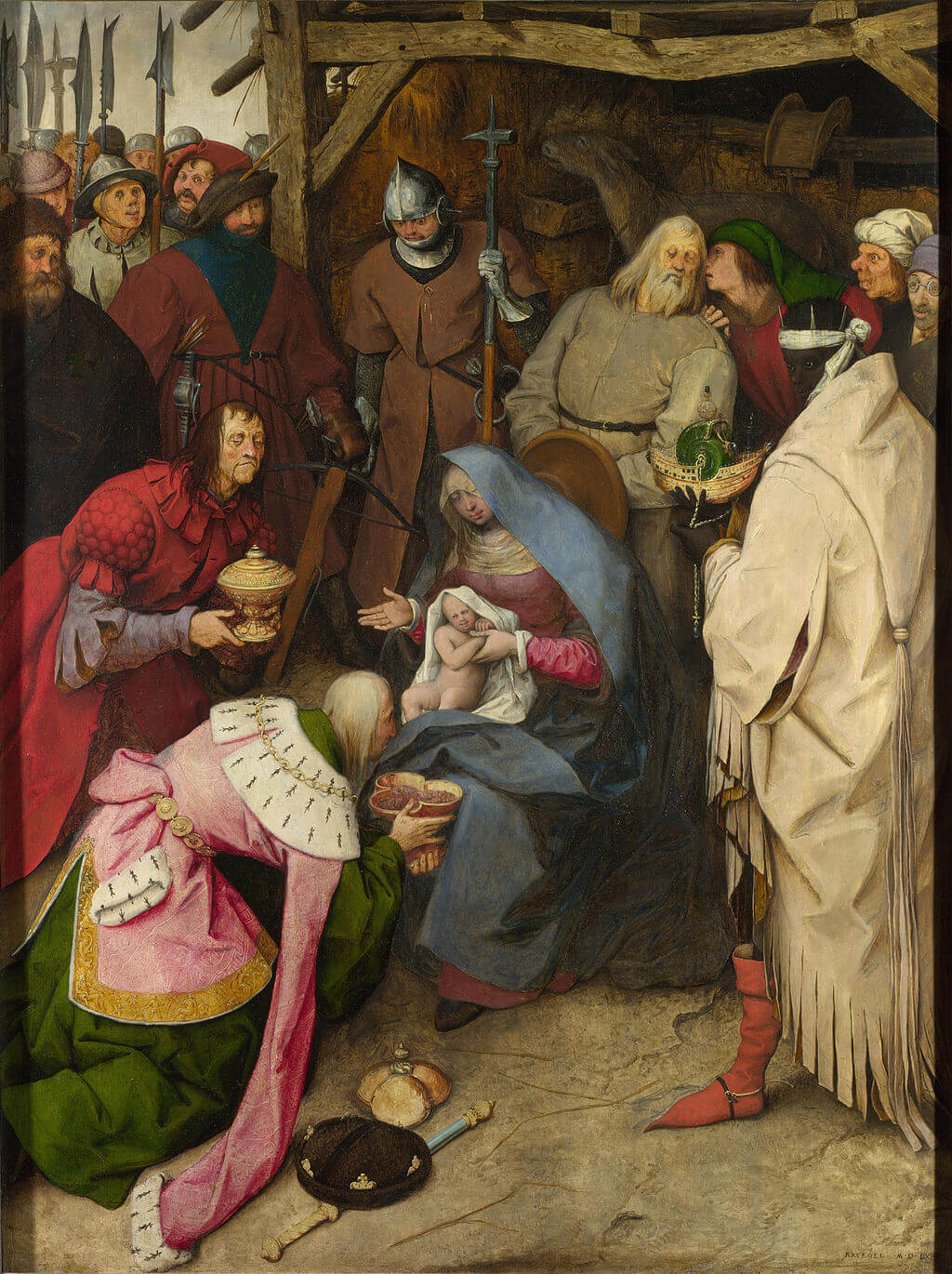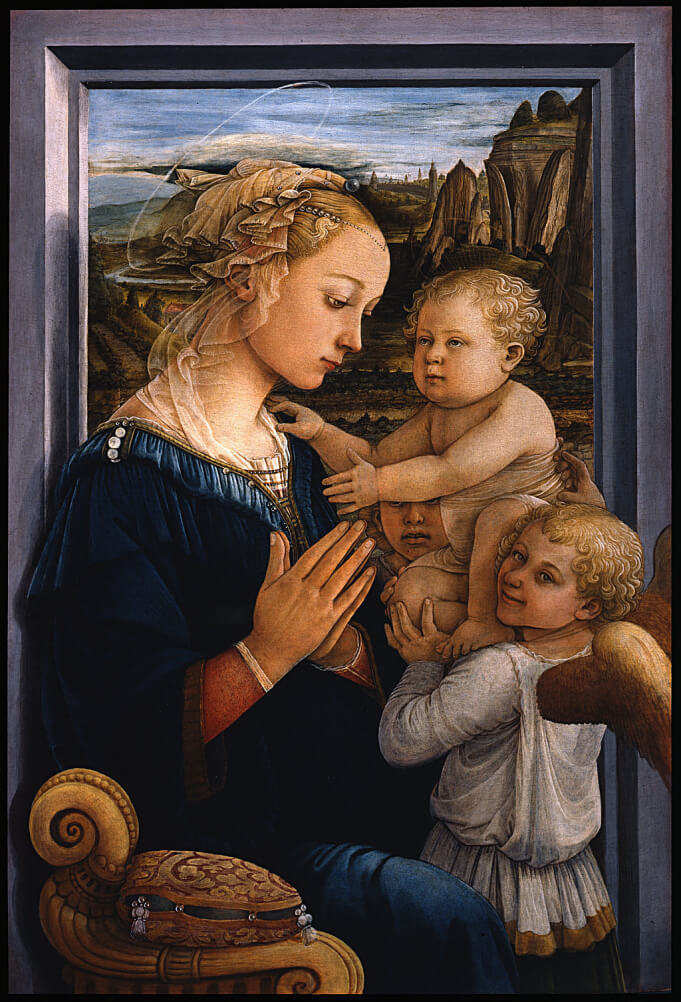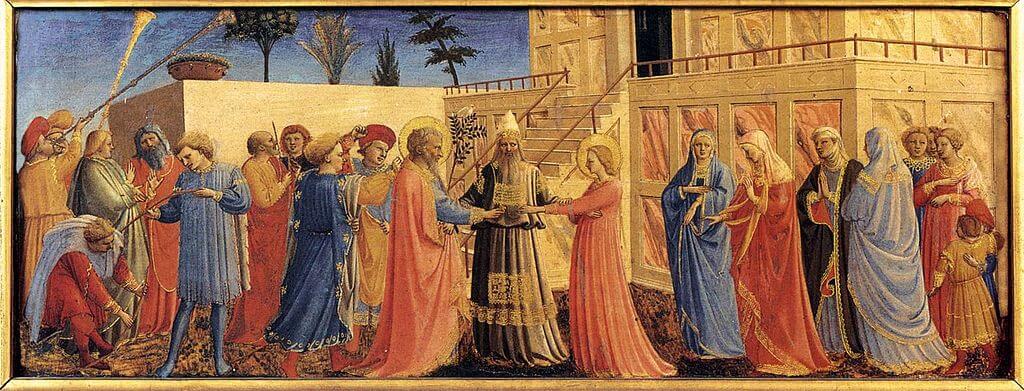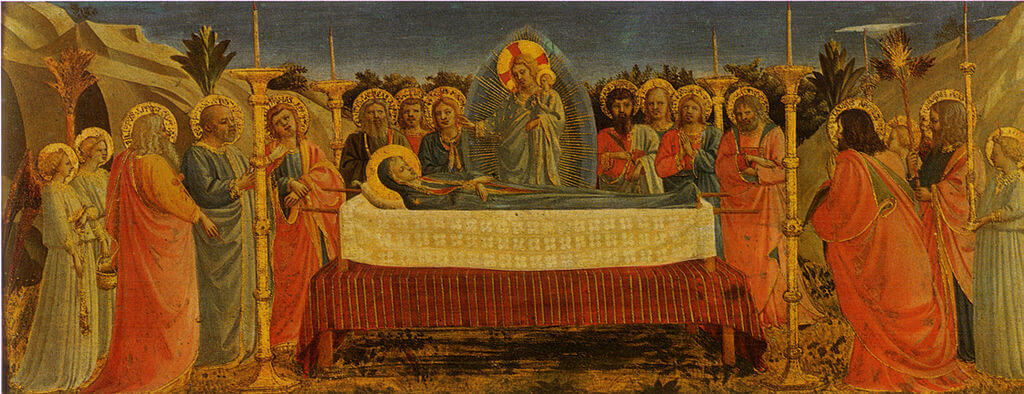|
Where? Gallery 4 of the National Gallery of Art
When? Between 1440 and 1460 Commissioned by? Most likely the Medici family What do you see? This tondo in a gold frame shows hundreds of people lining up to worship Baby Jesus. The line starts at the top right of the painting, goes around the back of the stable and the white building, and continues on the left side of the painting where people are entering under the arch. On the bottom right, the Holy Family is depicted. The Virgin Mary is wearing a blue dress and has Baby Jesus on her lap. You can see some pomegranate seeds next to the left hand of Jesus. To Mary’s right is Saint Joseph. To their left, you can see the typical donkey, ox, and manger. Behind and to the right of Mary and Joseph, you can see the three shepherds present at the birthplace of Jesus. In front of the line of people are the three Magi (also known as the three wise men or three kings) and behind them is their following. The first Magus is kneeling down in front of Jesus and touches his right foot. Jesus raises his right hand to bless him. The other two Magi are waiting behind him. The horses of the Magi are taken care of in the stable. Next to the stable is a group of blind and disabled people. Above them is a white architectural structure in decay and on top of this structure stands a group of five almost naked people. The painting contains various animals, such as cows, horses, camels, a donkey, an ox, a falcon, a peacock, a pheasant, and a dog. The two birds on the right of the stable probably represent a falcon (or a goshawk) attacking a pheasant. On the top right, next to the mountaintop, you can see even more faces cluttered together. Also, below the arch on the left, you can see sketches of more people and animals. Backstory: This painting is also known as the Washington Tondo or the Cook Tondo (named after a former owner of the painting). Fra Angelico started this painting, but before completing it, he was called to Rome by the Pope to complete several commissions in the Saint Peter and the Vatican Palace. Fra Filippo Lippi was then commissioned to finish the painting. In addition, it may be the case that several people in the workshops of both friars may have contributed to the painting. It is not entirely clear who painted which parts of the painting. The general idea is that Fra Angelico painted the figures with the thinner faces (like Mary) and Lippi painted the figures with the broader faces (like Saint Joseph and the Magus holding the foot of Jesus). It is thought that Filippo Lippi completed the majority of the painting. Symbolism: The painting contains various symbolic references:
Why the Adoration of the Magi? This theme was popular among Renaissance painters and has been painted by, among others, Botticelli, Pieter Bruegel the Elder, and Leonardo da Vinci. For example, Adoration of the Kings by Bruegel can be found in the National Gallery in London and Adoration of the Magi by Botticelli can be found in the Uffizi Museum in Florence. An important argument for the popularity of the adoration of the Magi theme is that artists could paint the luxury and colorfulness of the costumes of the Magi and their followers. This theme reflects the biblical story in Matthew 2 about the three kings who traveled a large distance following a big star to worship Baby Jesus. They brought three gifts for Jesus: gold, frankincense, and myrrh.
Who is Fra Angelico? Born as Guido di Petro around 1395, he was better known as Fra Angelico or Il Beato Angelico. He lived a very pious life and died in 1455. He started his career as a manuscript illustrator and moved on to become a painter of frescos and paintings.
He was beatified in 1982 by Pope John Paul II, because of his pious life and the amazing quality of his paintings. He was especially good in painting the most beautiful depictions of the Virgin Mary. One of his great works is the Coronation of the Virgin in the Uffizi Museum. Who is Filippo Lippi? Fra Filippo Lippi (1406-1469) was born in Florence. After his parents died and his aunt could not take care of him anymore, he was sent to a Carmelite convent. Unlike Fra Angelico, he lived a far-from-pious life, though he officially remained a friar throughout his life. He left the convent at age 26 and later in his life he even married and got a child, the well-known painter, Filippino Lippi. The Medici family recognized the talents of Filippo Lippi, and during his career, he completed at least nine paintings for them. One of his most famous works is the Madonna and Child with Two Angels in the Uffizi Museum.
Fun fact: An analysis by the National Gallery of Art has revealed that this painting was created over an extended period of time. It also seems that some of the animals in the painting were not initially included in the design, but only added later on, possibly by another painter than Fra Angelico and Filippo Lippi.
Analysis revealed, specifically, that the peacock, falcon, pheasant, and hunting dog were added on top of areas that were already painted. This was probably under the influence of the Medici brothers Piero and Giovanni. Note that the birds are painted bigger than they should realistically be, compared to the rest of the painting, to emphasize their symbolism. They distract the viewer from the real theme of the painting. Interested in a copy for yourself? Poster or canvas.
2 Comments
Where? Room 7 of the Uffizi Museum
When? Between 1430 and 1435 Commissioned by? The nuns of the Santa Maria Nuova hospital in Florence. What do you see? Jesus and the Virgin Mary are on top of a series of small clouds, floating in the sky. This painting depicts paradise. Jesus is crowning the Virgin Mary as the Queen of Heaven. Mary has her arms crossed on her chest, slightly bends forward, and has a humble look on her face, while Jesus is decorating her golden crown with a jewel stone. Surrounding Jesus and Mary is a crowd of angels, blessed people, and saints. A choir of angels is playing music and dancing. You can see several angels scattered throughout the painting, recognizable by their wings, who are either playing music or are dancing. Three angels are dancing directly to the left of Mary, and you can see three others directly to the right of Jesus. On the top right and top left you can see some trumpets high up in the air and in the center foreground you can see two angels playing musical instruments. The angel in blue, turned with the back towards us, is playing a portable organ, and the angel to the left is playing a string instrument. Backstory: The painting probably formed an altarpiece together with two side panels, Wedding of the Virgin and Death of the Virgin, which are now both located in the Museum of San Marco in Florence. The painting contains both elements that are Gothic and elements that are typical for the Renaissance. For example, the golden background is gilded and is an element that was common in Gothic painting. The use of halos is also typical Gothic. The realistic way in which the people are depicted and the three-dimensionality are examples of the Renaissance style.
Symbolism: The gold crown signifies both power (by being an advocate of the king) and wealth (regarding God’s promises). Jesus and Mary are surrounded by bright rays of light, symbolizing their divinity.
What is the Coronation of the Virgin? Mary is crowned by her son Jesus as the Queen of Heaven. This occurs after Mary has been assumed into heaven. In ancient times it was common for the king’s mother to be crowned queen. This subject was quite popular in art since the 13th century. Why is Mary the Queen of Heaven? One of the many titles that Catholics have given to Mary is Queen of Heaven (Regina Caeli in Latin). Historically, in the Bible, the mother of the king had important powers in counseling the king and she was referred to as the Queen Mother. The reason that Mary is sometimes called the Queen of Heaven is that, according to the Catholic Church, Mary was assumed into heaven at the end of her earthly life. In Heaven, she is crowned as the queen (which is the coronation of the Virgin) as she is the mother of Jesus, who is the heavenly king of the universe. On October 11, 1954, Pope Pius XII decided that Catholics should celebrate the Queenship of Mary. Since 1969, the Queenship of Mary is a public holiday on August 22 in several countries, such as France and Spain. Another work of Fra Angelico on the Coronation of the Virgin? The current version originally belonged to the Church of Sant'Egidio in Florence and is shown in the Uffizi since 1825. However, Fra Angelico has painted another well-known version of the Coronation of the Virgin. This version is currently in the Louvre in Paris. In that painting, you can see that blue skies replace the more old-fashioned Gothic golden background.
Who is Fra Angelico? Fra Angelico was born around 1387 as Guido di Pietro and died in 1455. He was a Dominican friar and was widely respected because of his gentle personality. While he started in the monastery as an illustrator of manuscripts, he became known as a masterful painter of altarpieces.
Only after his death the name Fra Angelico was given to him. In his work he freely interpreted biblical stories, rather than accurately depicting the stories, to trigger spiritual responses of the people seeing those paintings and to stimulate prayer. Among his well-known works is The Adoration of the Magi, painted together with Filippo Lippi, in the National Gallery of Art.
Fun fact: Fra Angelico was known during his life as Il Beato Angelico or simply Il Beato (which means ‘the blessed’). He was a devout friar during his life and only painted religious works. He prayed before every painting, and once the painting was done he did not alter them anymore as he believed that God inspired his work. While he was already called ‘the blessed’ during his life, Pope John Paul II officially beatified him in 1982, praising his immaculate lifestyle and divine paintings.
Interested in a copy for yourself? Poster or canvas. |
Categories
All
|
- Home
- Blog
-
Museums
- Alte Pinakothek
- Art Institute of Chicago
- Baltimore Museum of Art
- Barber Institute of Fine Arts
- Bargello
- Barnes Foundation
- British Museum
- Church of Sant’Anastasia
- Cleveland Museum of Art
- Courtauld Institute of Art
- Detroit Institute of Arts
- Frans Hals Museum
- Galleria Borghese
- Gallerie dell'Accademia
- Getty Museum
- Guggenheim
- Hermitage Museum
- Kunsthistorisches Museum
- Kunstmuseum Basel
- Legion of Honor Museum
- Louvre
- Mauritshuis
- Metropolitan Museum of Art
- Musee d’Orsay
- Museum of Fine Arts in Boston
- Museum of Modern Art
- National Gallery in London
- National Gallery of Art
- National Museum in Poznań
- Norton Simon Museum
- Ny Carlsberg Glyptotek
- Palace of Versailles
- Palazzo Pitti
- Palazzo Vecchio
- Petit Palais
- Philadelphia Museum of Art
- Prado
- Pushkin Museum
- Ravenna Art Museum
- Rijksmuseum
- San Diego Museum of Art
- Santa Maria delle Grazie
- St. Peter's Basilica
- Städel Museum
- Statens Museum for Kunst
- Tate Britain
- Tate Modern
- Timken Museum of Art
- Uffizi
- Vatican Museums
- Wallace Collection
-
Artists
- Altdorfer
- Anguissola
- Berlin Painter
- Bosch
- Botticelli
- Boucher
- Bronzino
- Bruegel the Elder
- Brunelleschi
- Cabanel
- Caillebotte
- Canova
- Caravaggio
- Carpeaux
- Cezanne
- Cimabue
- David
- Degas
- Delacroix
- De Maria
- Donatello
- El Greco
- Fontana
- Fra Angelico
- Fragonard
- Gauguin
- Gentileschi
- Gericault
- Gonzalez-Torres
- Goya
- Hals
- Hogarth
- Hokusai
- Ingres
- Leonardo da Vinci
- Lippi, Filippo
- Longhi, Barbara
- Lorrain
- Makovsky
- Manet
- Massys
- Matisse
- Merian
- Michelangelo
- Mochi
- Modigliani
- Monet
- Panini
- Parmigianino
- Perugino
- Picasso
- Pisanello
- Raphael
- Rembrandt
- Renoir
- Reynolds
- Rivera
- Rodin
- Rubens
- Scultori
- Seurat
- Steen
- Tintoretto
- Titian
- Toulouse-Lautrec
- Turner
- Uccello
- Van der Weyden
- Van Dyck
- Van Eyck
- Van Gogh
- Van Hemessen
- Vasari
- Velazquez
- Vermeer
- Veronese
- Vigée Le Brun
-
Locations
- Books
- About Us










